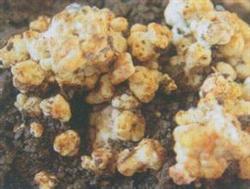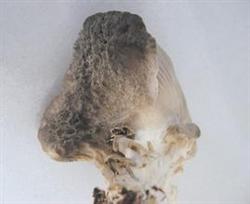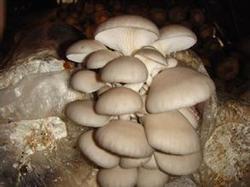Occurrence regularity and integrated control techniques of fleshy bacteria in Pleurotus ostreatus and walnut

Recently, many netizens have reported the harm of walnut fleshy bacteria in their Pleurotus ostreatus cultivation, and now reprint an article entitled "occurrence regularity and control techniques of walnut fleshy bacteria of Pleurotus ostreatus" published by Yang Yong an Xiurong of Taian Agricultural Science Research Institute in Shandong Province. for growers' reference: in recent years, walnut fleshy bacteria have occurred in some Pleurotus ostreatus planting sheds in Tai'an and its surrounding areas. Resulting in a reduction in production, and in serious cases, it will be wiped out. After several years of investigation and control experiments, the occurrence regularity and control techniques are introduced as follows. The main results are as follows: (1) the pathogen walnut fleshy fungus, also known as Streptomyces diellii, belongs to the subphylum of ascomycetes, Gymnocytidae. Yin silk white stout, separated, branched. Conidia serial or solitary. The ascomycete consists of a mass of loose and staggered hyphae, which is creamy at first and reddish brown when ripe, with irregular shape, reticular wrinkles like walnut kernel, and its straight diameter can reach 1: 3 cm. The ascospores are irregularly arranged, short and broad, containing 8 ascospores. Ascospores are colorless and nearly spherical. (2) due to the white and stout fleshy mycelium of walnut, the infection symptom could not be distinguished from that of Pleurotus ostreatus at the initial stage of infection. If walnut fleshy bacteria already exist in the culture material during or during the period of Pleurotus ostreatus, although the bag is full of white hyphae, it is difficult to produce mushrooms. If you break open the bag, you can smell a pungent smell of bleaching powder and the temperature is right. Walnut fleshy pathogen ascomycetes will appear at both ends of the bag. If walnut fleshy bacteria are infected after unbagged and covered with soil, the amount of mushrooms in the disease area is small, and in serious cases, there is no mushroom area, and cauliflower-like pathogen ascomycetes are formed in the soil layer. (3) Walnut fleshy fungus is a common native mold. Mushroom farm operation, handling soil, bacteria carrying bacteria, culture materials carrying bacteria, sewage, air mycelium fragments, can spread the disease. (4) the optimum temperature for ascospore germination was 30 ℃, and the feed temperature was maintained for a short period of about 28 ℃, and then fell back to a lower temperature, which could stimulate the development of the pathogen. Ascospores could be killed after 30 min (min) treatment at 60 ℃, but dry ascospores could not be eliminated after 80 ℃ treatment for 2 h. Under the acidic condition, the culture material and soil cover are beneficial to the spore germination and mycelium growth of the pathogen, and the high temperature and humidity of the mushroom room and poor ventilation are beneficial to the occurrence of the disease. (5) the prevention and control measures ① and mushroom shed should be disinfected strictly before use. Close fumigation with 5 g potassium permanganate and 10 ml formaldehyde per use. Turn on ventilation after 2 days, and then use it. The surface layer of the old mushroom house was shoveled with 3-4 cm, and the subsoil of the vegetable field was dug and backfilled. When ② and culture material were mixed, the pH value showed alkaline reaction. ③, select high-quality bacteria, remove bacteria with hard lump or bleach flavor. ④ and germicidal temperature should be controlled at 10-16 ℃ as far as possible, and the temperature in the material should be controlled below 25 ℃. ⑤, try to use bag cultivation, wall mushroom, instead of covering soil to produce mushrooms. If mushrooms are produced by covering the soil, the covered soil can be mixed with 10% lime powder, do not water on the same day after taking off the bag and cover the soil, and then pour enough water after 2-3 days after the surface mycelium recovers. ⑥, keep the air in the mushroom shed unobstructed, avoid high temperature and humidity, or cool down with the high temperature in a short time, and inhibit the occurrence of bacteria. ⑦, once it is found that the culture bag is damaged, you should carefully remove the soil cover and the culture bag completely, and spray around with 50% carbendazim or lime water. The fruiting body of the removed fungus should be buried far away from the mushroom shed to prevent the spread of spores. ⑧, timely removal of waste mushrooms, keep the mushroom clean and hygienic. ⑨, spraying the disease area with 3000 ~ 5000 times benzoate solution has a certain control effect. In addition, this paper introduces the comprehensive control technology of fleshy bacteria of Pleurotus ostreatus published by Miao Lijun of Agriculture Bureau of Wuji County, Hebei Province. A destructive disease-walnut fleshy bacteria has occurred in the production of Pleurotus ostreatus in the past two years. The disease mostly occurs in the vegetative growth stage of Pleurotus ostreatus. In the early stage of the disease, the hyphae were white and difficult to distinguish from the normal hyphae, but in the later stage, the ascus was shaped like a walnut and distributed on the surface of the culture material. When the bacterial bag is infected, it has a pungent smell of bleaching powder. once the bacterial bag is infected, it is difficult to produce mushrooms again, which often leads to the failure of harvest in a large area. Walnut fleshy bacteria mainly spread through three ways: seed-borne bacteria, spore transmission and soil transmission. Control methods: 1 the selection of excellent bacteria is the basis of high yield and harvest of Pleurotus ostreatus. In production, high-quality bacteria produced by regular scientific research institutions and large strain factories must be selected to avoid pollution caused by seed-borne bacteria. (2) after strict disinfection of mushroom shed in winter, physical disinfection can be carried out in high temperature greenhouse from June to July in summer, and it can be disinfected continuously for 5 to 7 days. The chemical disinfection can be fumigated with sulfur 12-15 g, or the surface of the wall, scaffolding, bed and plastic film can be disinfected with lime water with a pH value of 12-14. (3) in the cultivation of fermented materials, all kinds of ingredients were mixed well, the amount of water was adjusted to appropriate, the pH value was adjusted to 12 ~ 14, and the width of fermentation stack was 1.2 ~ 1.5 m, which was lengthened vertically. At the waist of the pile, use 4-6 cm sticks in diameter and punch 2-4 rows of air holes at intervals of 30-40 crn to the bottom. After stacking, the material temperature begins to rise, and when the material center temperature rises above 60 ℃, start the clock, keep 24 h and start turning the pile for the first time. When turning the pile, the material should be shaken and loosened thoroughly. The reactor was rebuilt and the fermentation ended for 24 hours when the central temperature of the material was raised above 60 ℃. Re-adjust the water content to 60%-65%, pH 7.5-8.O can be bagged. (4) the covering soil should be thoroughly disinfected when covered with soil. The covering soil needed for the cultivation of Pleurotus ostreatus should choose the deep sandy loam away from the mushroom shed. Add 1% quicklime powder, spray 10%-15% formaldehyde solution, spray while stirring, 100kg soil need to add liquid 1~1.5kg, film for 24 hours, remove excess formaldehyde gas can be used. Walnut fleshy bacteria are found in the process of cultivation, first of all, the contaminated cultivation bags should be taken out of the mushroom shed to be buried and burned, and the treatment should be clean. Secondly, other bacterial bags, mushroom shed and ground were thoroughly sprayed with lime water with pH value of 12~l4 once. Reduce the unnecessary flow of operators and non-production personnel, and control the further spread of germs. If there are conditions, it is best to adopt the method of complete isolation and do further treatment.
- Prev

Comprehensive control techniques of green mold in Pleurotus ostreatus
1. The cap of Pleurotus ostreatus is small, the differentiation is poor, and the stalk is longer. The reason was that during the period of primordium formation and differentiation, the mushroom room was anoxic, the light was insufficient, and the temperature was high, which affected the normal differentiation and development of the cap. Prevention and treatment methods: strengthen ventilation, adjust light and temperature. two。 Pleurotus ostreatus lid performance, mainly the edge.
- Next

Two stubble noodles of Pleurotus ostreatus should be peeled.
The economic benefit of planting Pleurotus ostreatus with peanut shell is 9.67% and 21.82% higher than that of rice straw cultivation. The following links should be grasped in the process of operation. Raw material treatment and formula crush the peanut shell into small particles and set aside after exposure to the sun for 2 or 3 days. The formula is: peanut shell 90%, wheat husk or rice bran 8% lime 3%, phosphorus.
Related
- Fuxing push coffee new agricultural production and marketing class: lack of small-scale processing plants
- Jujube rice field leisure farm deep ploughing Yilan for five years to create a space for organic food and play
- Nongyu Farm-A trial of organic papaya for brave women with advanced technology
- Four points for attention in the prevention and control of diseases and insect pests of edible fungi
- How to add nutrient solution to Edible Fungi
- Is there any good way to control edible fungus mites?
- Open Inoculation Technology of Edible Fungi
- Is there any clever way to use fertilizer for edible fungus in winter?
- What agents are used to kill the pathogens of edible fungi in the mushroom shed?
- Rapid drying of Edible Fungi

